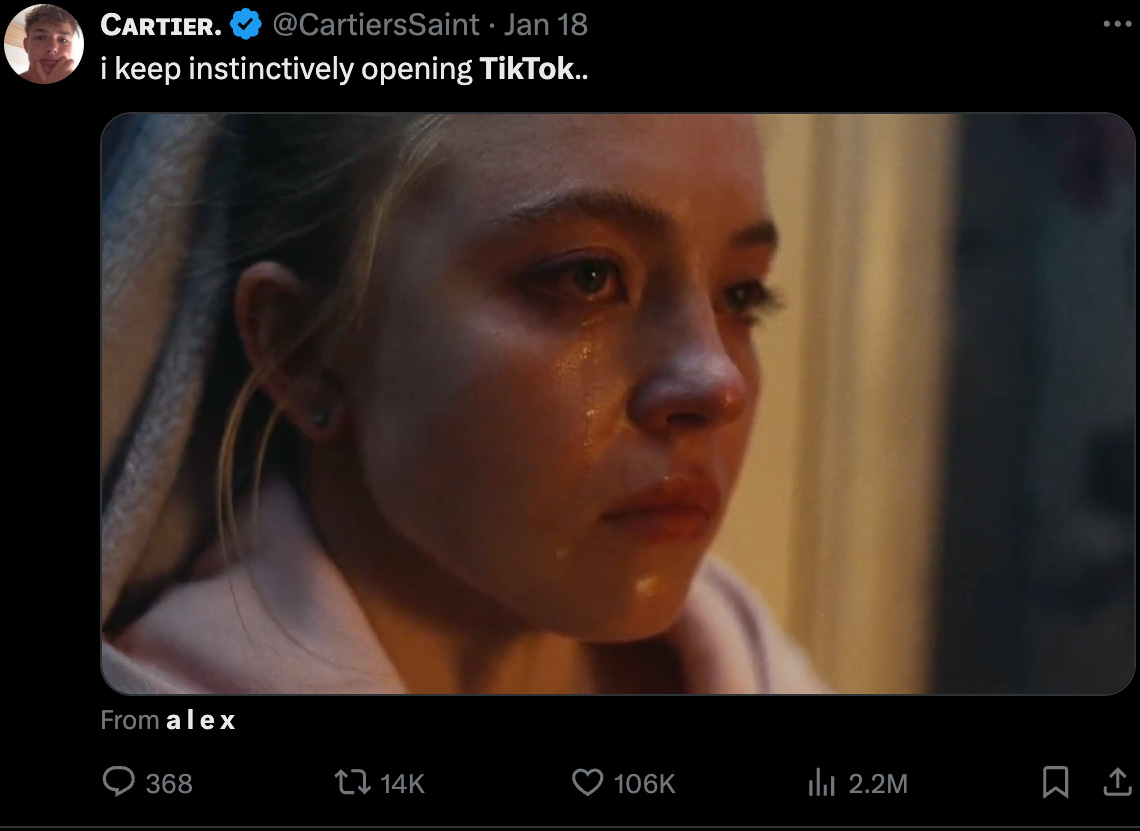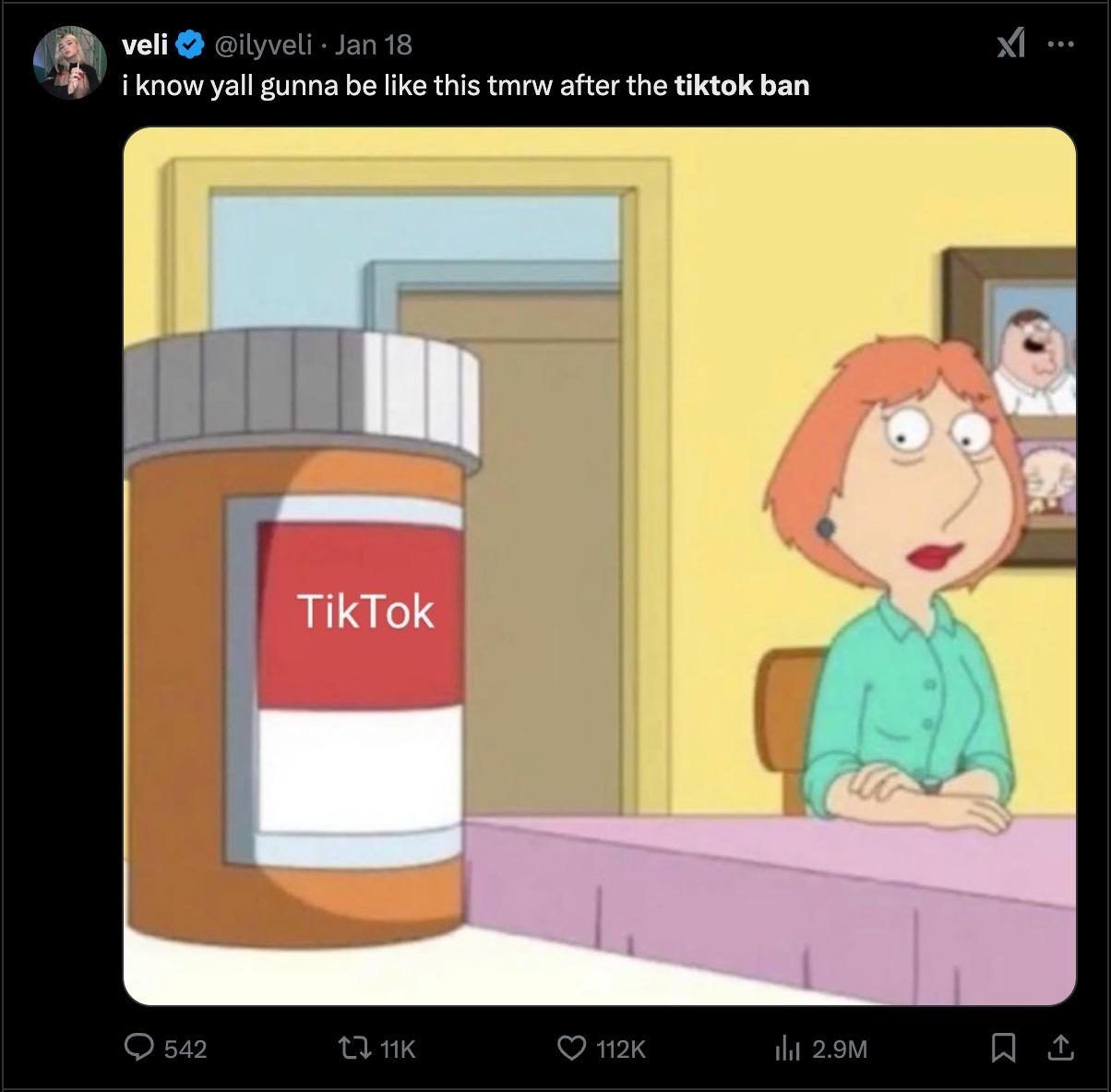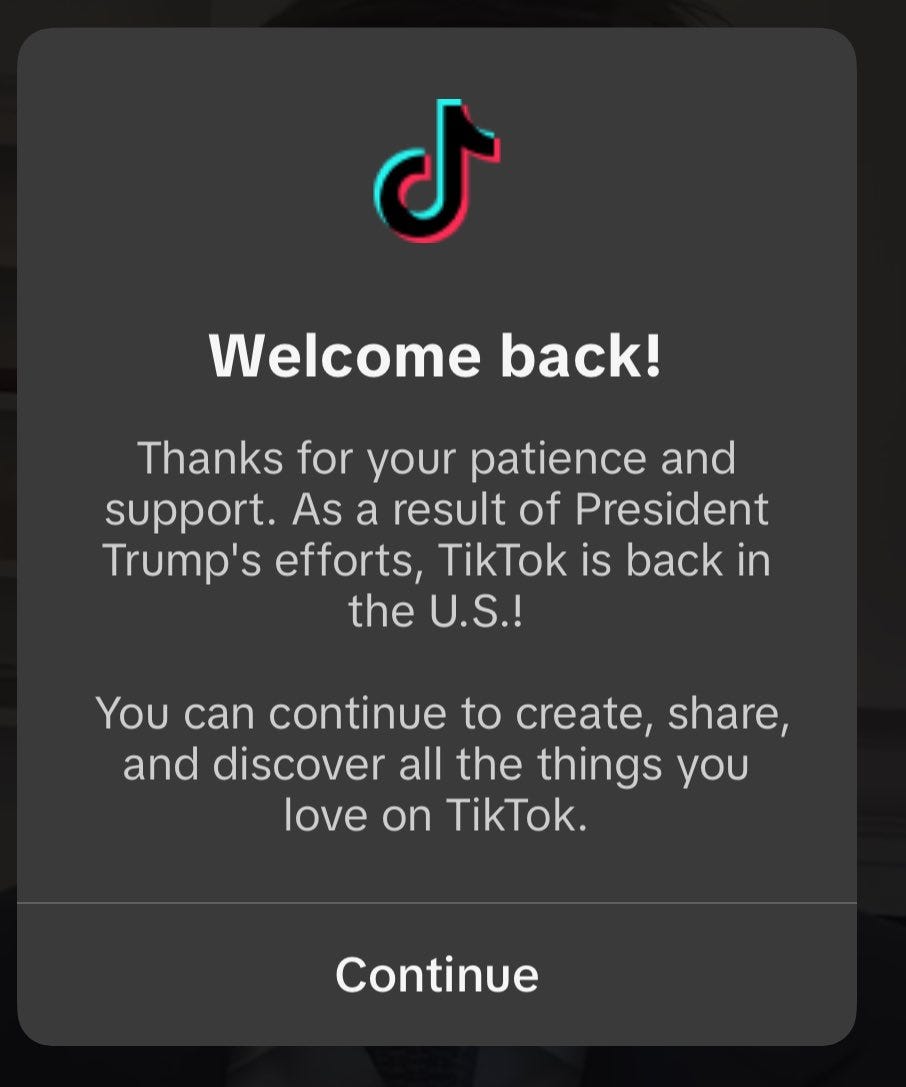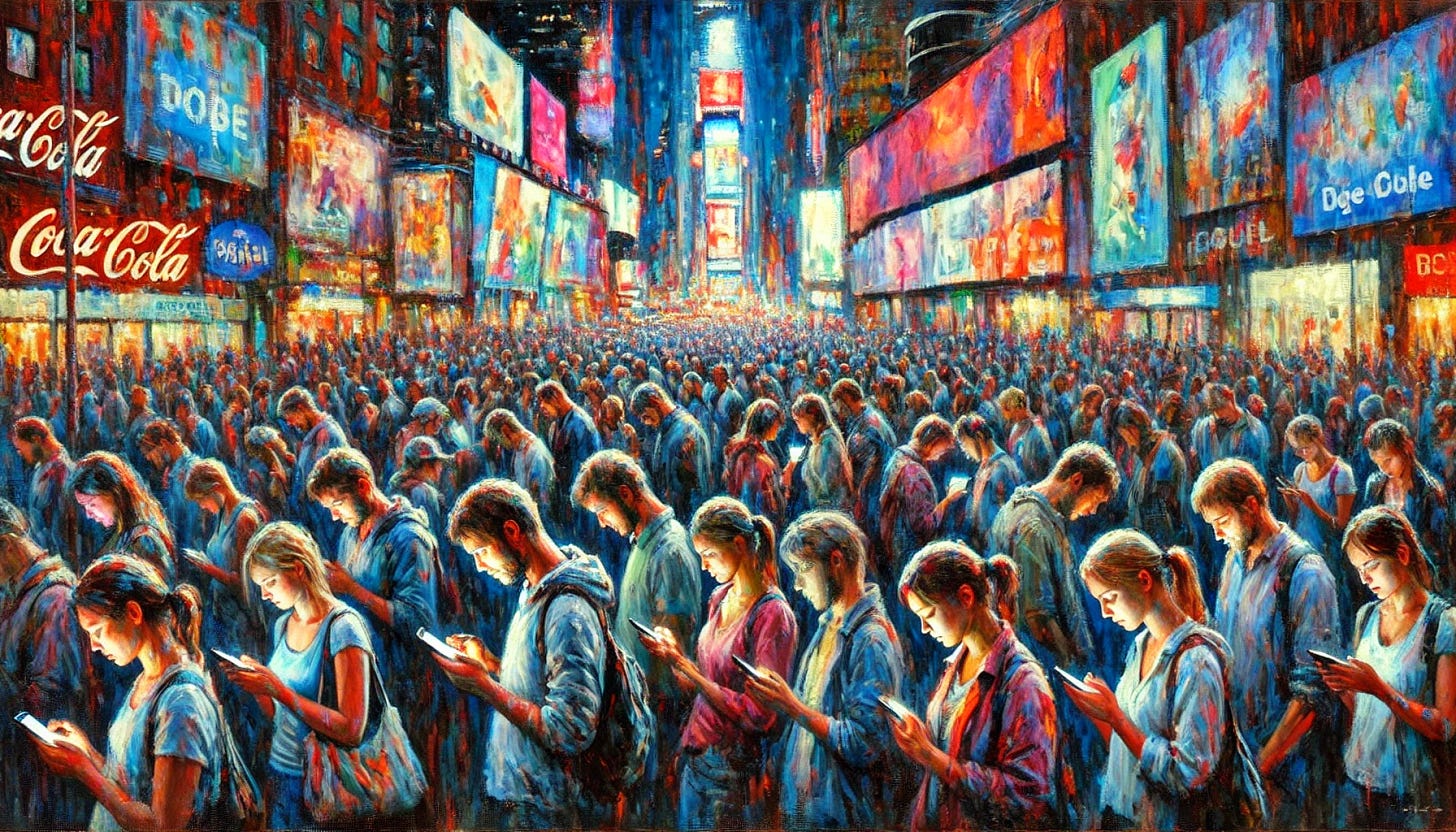The TikTok ban, short form content, and the death of prolonged attention
TikTok was shut off in the U.S. for ~12 hours, and people were not okay.
On Saturday evening of January 18th, TikTok was shut off in the U.S. for ~12 hours, and people were not okay.123
And then…it was turned back on (although you likely still cannot download the app):
While now (mostly) accessible once again, TikTok’s long-term future in the U.S. is still up in the air.4
I don’t feel sufficiently informed to discuss the ban given the complex impacts the app could have on data privacy, national security, and TikTok creators, but I do want to discuss the effects of TikTok content (and all short-form content) on our attention spans – whether or not TikTok remains accessible in the U.S.
Short-form content and the ultra-personalized algorithms that accompany it can be blamed for a myriad of effects on our brain including difficulty focusing on long tasks, a reduced sense of self control, and excess activation of the reward center of the brain.5
The thread weaving itself through all these effects is the deterioration of our attention. TikTok and other short-form content platforms have created a tapestry of the superficial, fast, cheap, and effortless, and it is where millions choose to spend much of their discretionary time.
Understanding attention (and distraction)
To understand how short-form content has caused our attention spans to deteriorate, we must understand attention – and its opposite – distraction. William James, psychologist and philosopher said:6
"Every one knows what attention is. It is the taking possession by the mind, in clear and vivid form, of one out of what seem several simultaneously possible objects or trains of thought. Focalization, concentration, of consciousness are of its essence. It implies withdrawal from some things in order to deal effectively with others, and is a condition which has a real opposite in the confused, dazed, scatterbrained state which in French is called distraction, and Zerstreutheit in German."
For James, distraction is the opposite of attention. Here’s what he has to say about the mind in a distracted state:
"The eyes are fixed on vacancy, the sounds of the world melt into confused unity, the attention is dispersed so that the whole body is felt, as it were, at once, and the foreground of consciousness is filled, if by anything, by a sort of solemn sense of surrender to the empty passing of time."
How do you feel upon emerging from a vortex of social media scrolling?
James’s description of a “solemn sense of surrender to the empty passing of time” captures the feeling more accurately than any other description I’ve read. He continues:
“It is not sleep; and yet when aroused from such a state, a person will often hardly be able to say what he has been thinking about.”
James believes that each person shapes their life experience by choosing where to direct their attention.
Imagine you’re standing on top of a mountain, and the view is breathtaking. You may reflect deeply on the landscape around you, creating an embedded life experience. Or, you may choose to direct your attention elsewhere: a conversation with the person next to you, a text message on your phone, the creation of an Instagram-worthy image.
If you simply let your mind flow with the current of distraction, shifting from the view to the people to your phone to a photo, none of these things will become a solidified part of your existence, or as James explains, “only those items which I notice shape my mind—without selective interest, experience is an utter chaos.”
Why attention matters
An October 2024 study by the Shantou University Medical College in China found that ~24% of college students in China are addicted to short-form video (SFV), where addiction was defined as “a chronic or cyclical state of obsession caused by repeatedly using SFV apps, which results in intense and persistent feelings of need and dependence to SFVs.”
The study found a strong negative correlation between self-control and short-form video addiction. While self-control is seen as a finite resource in the short term (each of us can only exercise so much self-control per day), it can be strengthened as people regularly engage in tasks that require self-control and build resilience.7
What types of activities help expand one’s capacity for self-control? Naturally, these are activities that require sustained attention and the capacity to continue through discomfort.
We can rebuild our attention spans, but it will require a willingness to engage with hard problems, nourish complex relationships, practice physically and mentally-stimulating hobbies, and design a (mostly) distraction-free environment.
Jonhan Hari, in his book Stolen Focus, asserts that democracy is deteriorating as our attention spans deteriorate:
“Democracy requires the ability of a population to pay attention long enough to identify real problems, distinguish them from fantasies, come up with solutions, and hold their leaders accountable if they fail to deliver them…People who can't focus will be more drawn to simplistic authoritarian solutions--and less likely to see clearly when they fail. A world full of attention-deprived citizens alternating between Twitter and Snapchat will be a world of cascading crises where we can't get a handle on any of them.”8
At work, deteriorated attention spans are eroding employees’ capacity to work on hard problems and make a meaningful contribution. Of 1,200 U.S. employees and employers, 79% of workers said they can’t go a full hour without getting distracted from work; 59% couldn’t go just 30 minutes without encountering a diversion.9
Modern entertainment and modern work alike have designed systems that prioritize superficial, bite-sized stimulation over complex, sustained activities. Gloria Mark, in her book Attention Span: A Groundbreaking Way to Restore Balance, Happiness and Productivity, explains that we must “reframe our goal from that of maximizing human productivity with our devices, to instead using them in maintaining a healthy psychological balance, while still achieving our aims.”10 Short-form content maximizes dopamine when compared to most other pastimes, and email/Teams/Slack maximize speed when compared to other work activities, but neither group promotes long-term satisfaction and progress.
We need prolonged attention to thrive
In communities, at work, and at home, giving important topics our prolonged attention is requisite for progress and fulfillment.
We have limited computational resources, and short-form stimulation bombards us from every angle, shattering our computational resources into a million tiny, (and largely worthless) pieces.
It takes serious effort to design an environment where you can focus and pay attention, but Gloria Mark believes it is possible: “I believe that people can gain control over their attention. We're not victims to technology. We're not victims to algorithms.”
Here are some ideas to help you increase your attention span:
Commit to spending one consecutive hour of each day screen-free (ideally spent in a state of sustained focus like reading, exercising, drawing, building, cooking, conversing, etc.).
Delete all sources of short-form content from your phone.
Turn on do not disturb all or most of the time.
Clean and organize your space at work and home. Place things in sight that promote sustained attention, and hide things that may distract you.
Keep a sticky note or piece of paper near your desk, and write down anything that you’re distracted by. Once you write it down, immediately go back to the task you were focusing on.
Close all tabs on your computer except the ones needed to perform your current task.
Schedule two or three 30-minute time blocks each day to respond to texts and emails.
When you feel you can’t focus, stand up and go for a walk, brush your teeth, stretch, drink water, or practice deep breathing.
I still struggle to hold sustained attention on one thing for long periods of time, and I I wrote these ideas for myself as much as anyone else.
But as William James explained, a life where we do not direct and sustain our attention is chaos.
It is worth it for each of us to counteract the design of short-form content and intentionally direct and sustain our attention, every day.
@ilyveli. "I'm convinced tiktok has destroyed our attention spans." Twitter, 7 Jan. 2024, 7:44 p.m., twitter.com/ilyveli/status/1880805719043436743.
@fairyftdt. "tiktok has destroyed our attention span." Twitter, 7 Jan. 2024, 8:59 p.m., twitter.com/fairyftdt/status/1880824589783376274.
@CartiersSaint. "tiktok has destroyed our attention span." Twitter, 7 Jan. 2024, 9:14 p.m., twitter.com/CartiersSaint/status/1880828508802564217.
"Restrictions on TikTok in the United States." Wikipedia, Wikimedia Foundation, 20 Jan. 2025, en.wikipedia.org/wiki/Restrictions_on_TikTok_in_the_United_States. Accessed 20 Jan. 2025.
TikTok Brain Explained: Why Some Kids Seem Hooked on Social Video Feeds." The Wall Street Journal, 2 Apr. 2022, www.wsj.com/articles/tiktok-brain-explained-why-some-kids-seem-hooked-on-social-video-feeds-11648866192.
James, William. "Attention." The Principles of Psychology, 1890. Classics in the History of Psychology, York University, psychclassics.yorku.ca/James/Principles/prin11.htm. Accessed 19 Jan. 2025.
Wu S, Shafait Z, Bao K (2024) The relationship between proactive personality and college students’ short-form video addiction: A chain mediation model of resilience and self control. PLoS ONE 19(11): e0312597. https://doi.org/10.1371/journal.pone.0312597
Hari, Johann. Stolen Focus: Why You Can't Pay Attention - and How to Think Deeply Again. Crown, 2022.
Most Workers Can't Go an Hour without Getting Distracted, Study Finds." Fortune, 3 July 2024, fortune.com/2024/07/03/workplace-attention-span-most-workers-distracted-gen-z-insightful-report/.
Mark, Gloria. Attention Span: A Groundbreaking Way to Restore Balance, Happiness and Productivity. Hanover Square Press, 2023.






